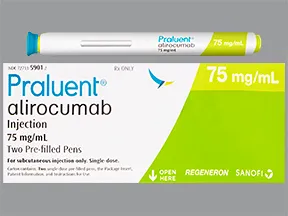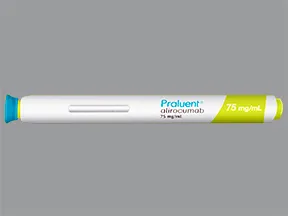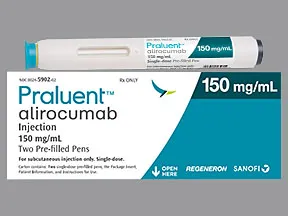Dosing & Uses
Dosage Forms & Strengths
injection, solution
- Prefilled, single-dose pen for SC injection
- 75mg/mL
- 150mg/mL
Hyperlipidemia Treatment and/or CV Risk Reduction
Indications
-
Primary hyperlipidemia (including heterozygous familial hypercholesterolemia)
- Indicated as an adjunct to diet, alone or in combination with other lipid-lowering therapies (eg, statins, ezetimibe), for treatment of primary hyperlipidemia to reduce low-density lipoprotein cholesterol (LDL-C)
-
Prevention of cardiovascular events
- Indicated to reduce the risk of MI, stroke, and unstable angina requiring hospitalization in adults with established cardiovascular (CV) disease
-
Homozygous familial hypercholesterolemia
- Indicated as an adjunct to other LDL-C-lowering therapies in adults with homozygous familial hypercholesterolemia (HoFH) to reduce LDL-C
Established CV disease or primary hyperlipidemia, including HeFH
- 75 mg SC q2Weeks or 300 mg SC q4Weeks initially
- For patients on 300 mg q4Weeks, measure LDL-C just prior to next scheduled dose; LDL-C can vary between doses in some patients
- If LDL-C response inadequate, may adjust dose by 150 mg SC q2Weeks
Patients with HeFH undergoing apheresis or with HoFH
- 150 mg SC q2Weeks
- May be administered without regard to timing of apheresis
Dosage Modifications
Renal impairment
- Mild or moderate: No dose adjustment required
- Severe: Not studied
Hepatic impairment
- Mild or moderate: No dose adjustment required
- Severe: Not studied
Dosing Considerations
Assess LDL-C when clinically appropriate; may be measured as early as 4 weeks after initiation
Dosage Forms & Strengths
injection, solution
- Prefilled, single-dose pen for SC injection
- 75mg/mL
- 150mg/mL
Heterozygous Familial Hypercholesterolemia
Indicated as an adjunct to diet and other LDL-C-lowering therapies in children aged ≥8 years with heterozygous familial hypercholesterolemia (HeFH) to reduce LDL-C
<50 kg
- 150 mg SC q4Weeks
- If inadequate LDL-C lowering response, may adjust dose to 75 mg SC q2Weeks
≥50 kg
- 300 mg SC q4Weeks
- If inadequate LDL-C lowering response, may adjust dose to 150 mg SC q2Weeks
Dosing Considerations
Assess LDL-C when clinically appropriate; may be measured as early as 4 weeks after initiation
Adverse Effects
>10%
Nasopharyngitis (11.3%)
1-10%
Allergic reactions (8.6%)
Injection site reactions (7.2%)
Influenza (5.7%)
Antidrug antibodies (4.8%)
Urinary tract infection (4.8%)
Diarrhea (4.7%)
Bronchitis (4.3%)
Myalgia (4.2%)
Muscle spasms (3.1%)
Sinusitis (3%)
Liver-related disorders (2.5%)
Cough (2.5%)
Contusion (2.1%)
Musculoskeletal pain (2.1%)
Postmarketing Reports
Angioedema
Vasculitis
Warnings
Contraindications
History of serious hypersensitivity reaction to alirocumab or its exceipeints; reactions have included hypersensitivity vasculitis, angioedema, and hypersensitivity reactions requiring hospitalization
Cautions
Hypersensitivity reactions (eg, pruritus, rash, urticaria), including some serious events (eg, hypersensitivity vasculitis and hypersensitivity reactions requiring hospitalization), have been reported; discontinue and treat if signs or symptoms of serious allergic reactions occur
Pregnancy
Pregnancy
Available data from clinical trials and postmarketing reports in pregnant females are insufficient to evaluate for drug-associated risk of major birth defects, miscarriage, or other adverse maternal or fetal outcomes
There is a pregnancy safety study if administered during pregnancy; report exposure (1-844-734-6643)
Animal studies
- Studies in rats have not shown effects on embryo-fetal development when given during organogenesis up to 12-fold the human exposure
- In monkeys, suppression of the humoral immune response was observed in infant monkeys when alirocumab was dosed during organogenesis to parturition at dose exposures 13-fold the exposure at the maximum recommended human dose of 150 mg q2wk
- Measurable alirocumab serum concentrations observed in infant monkeys at birth at comparable levels to maternal serum, indicating that it crosses the placental barrier; monoclonal antibodies are transported across placenta in increasing amounts especially near term; therefore, it has the potential to be transmitted from mother to developing fetus
Lactation
Unknown if distributed in human breast milk
The development and health benefits of breastfeeding should be considered along with the mother’s clinical need for the drug and any potential adverse effects on the breastfed infant
Human IgG is present in human milk, but published data suggest that breastmilk IgG antibodies do not enter the neonatal and infant circulation in substantial amounts
Pregnancy Categories
A: Generally acceptable. Controlled studies in pregnant women show no evidence of fetal risk.
B: May be acceptable. Either animal studies show no risk but human studies not available or animal studies showed minor risks and human studies done and showed no risk. C: Use with caution if benefits outweigh risks. Animal studies show risk and human studies not available or neither animal nor human studies done. D: Use in LIFE-THREATENING emergencies when no safer drug available. Positive evidence of human fetal risk. X: Do not use in pregnancy. Risks involved outweigh potential benefits. Safer alternatives exist. NA: Information not available.Pharmacology
Mechanism of Action
Monoclonal antibody that binds to PCSK9 (proprotein convertase subtilisin/kexin type 9)
LDL-C is cleared from the circulation preferentially through the LDL receptor (LDLR) pathway
PCSK9 is a serine protease that destroys LDLR in the liver, resulting in decreased LDL-C clearance and increased plasma LDL-C
PCSK9 inhibitors decrease LDLR degradation by PCSK9, and thereby improve LDL-C clearance and lower plasma LDL-C
Absorption
Absolute bioavailability: 85%
Peak plasma time: 3-7 days
Distribution
Vd: 0.04-0.05 L/kg
Distributed primarily in circulatory system
Metabolism
Specific metabolism studies were not conducted because alirocumab is a protein and is expected to degrade to small peptides and individual amino acids
Does not affect P450 enzymes, P-gp, and OATP
Elimination
Half-life: 17-20 days
Administration
SC Preparation
Allow prefilled pen to warm to room temperature for 30-40 minutes prior injection; administer as soon as possible after it has warmed up
Visually inspect for particulate matter and discoloration before administration; discard if solution is discolored or contains visible particulate matter
Follow aseptic injection technique for every administration time
SC Administration
Administer by SC injection into areas of thigh, abdomen, or upper arm that are not tender, bruised, red, or indurated
Rotate injection site with each administration
Administer 300-mg dose by giving two 150-mg injections consecutively at 2 different injection sites
Do not coadminister with other injectable drugs at same injection site
Instructions for patients/caregivers
- Provide proper training to patients and/or caregivers on preparation and administration prior to use
- Adolescents aged 12-17 years: Administer by adult or under adult supervision
- Children aged 8-11 years: Administer by caregiver
Missed dose
- ≤7 days: Resume original schedule
-
>7 days
- Every 2 weeks regimen: Wait until next scheduled dose
- Every 4 weeks regimen: Administer missed dose and start new scheduled based on this date
Storage
Refrigerate at 36-46°F (2-8°C) in the outer carton in order to protect from light
If needed, may store up to 30 days at room temperature not exceeding 77°F (25°C) in original container
Do not freeze
Do not expose to extreme heat
Do not shake
Images
| BRAND | FORM. | UNIT PRICE | PILL IMAGE |
|---|---|---|---|
| Praluent Pen subcutaneous - | 150 mg/mL injection |  | |
| Praluent Pen subcutaneous - | 75 mg/mL injection |  | |
| Praluent Pen subcutaneous - | 150 mg/mL injection |  | |
| Praluent Pen subcutaneous - | 75 mg/mL injection |  | |
| Praluent Pen subcutaneous - | 75 mg/mL injection |  | |
| Praluent Pen subcutaneous - | 75 mg/mL injection |  | |
| Praluent Pen subcutaneous - | 150 mg/mL injection |  | |
| Praluent Pen subcutaneous - | 150 mg/mL injection |  | |
| Praluent Pen subcutaneous - | 75 mg/mL injection |  |
Copyright © 2010 First DataBank, Inc.
Formulary
Adding plans allows you to compare formulary status to other drugs in the same class.
To view formulary information first create a list of plans. Your list will be saved and can be edited at any time.
Adding plans allows you to:
- View the formulary and any restrictions for each plan.
- Manage and view all your plans together – even plans in different states.
- Compare formulary status to other drugs in the same class.
- Access your plan list on any device – mobile or desktop.





